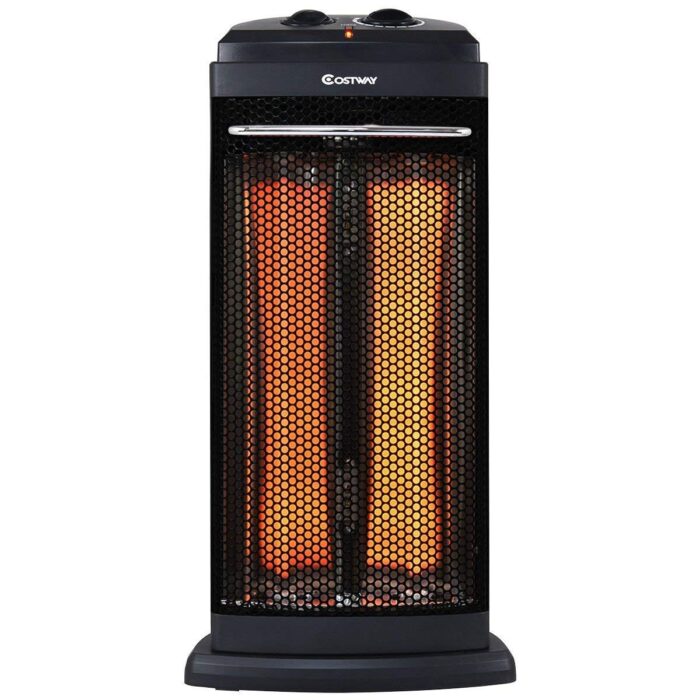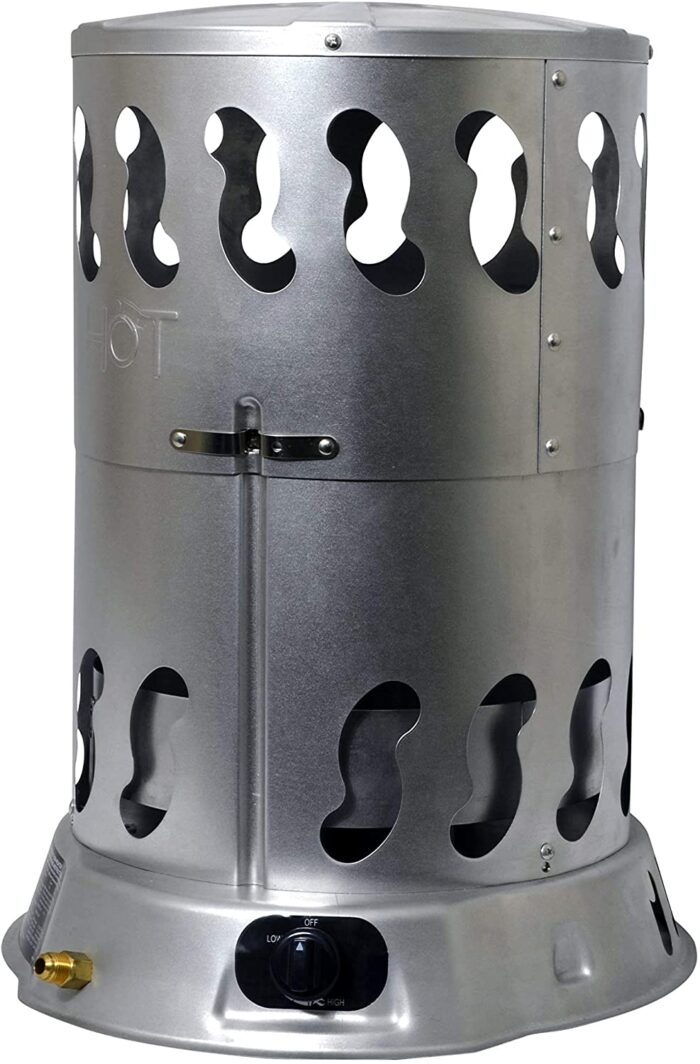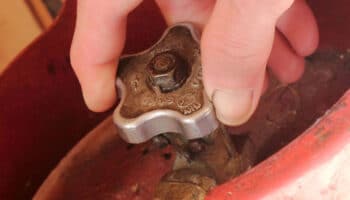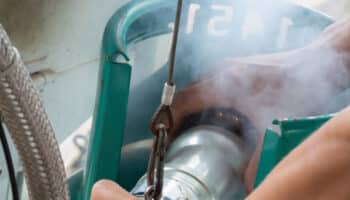Are you desperately trying to figure out whether you should heat your unfinished basement?
That’s a tough one! With so little information out there regarding this situation, it can be really easy to feel confused and overwhelmed.
Basements are not only naturally creepy but also very cold, so any chance you get at warming it up a little is a chance you should take. But how can you raise the temperature in an empty room without paying a fortune in electricity bills?
That’s the million-dollar question, but don’t worry; you came to the right place for answers.
Below, I’ve prepared an article that will explain everything you need/want to know about heating your unfinished basement.
If you have cold floors, insulating the basement ceiling will help the most. Once insulated, heating an unfinished basement will help warm your whole home. Placing rugs can also help raise the temperature in the area.
Keep reading to uncover all the secrets to a cozy basement!
Why trust us? This article was written by Craig Anderson and Brian Paul.
Craig has helped thousands of other homeowners repair their appliances since 2016.
Insulating and Heating Your Unfinished Basement
Insulating and heating an unfinished basement doesn’t need to be a complicated task. Generally, all you need to do is add some simple materials to the walls, ceiling, and, optionally, floor.
Even doing some simple and minor spot fixes can make a huge difference!
I borrowed The illustrations below from a great insulation guide at Natural Resources Canada. Before performing any work, always fully check and prepare the wall/floor/ceiling before installation. Check and seal any drafts, especially any water leaks.
Insulating Basement Walls & Floor
Wall insulation when heating an unfinished basement is typically done by adding some insulating material to the wall, and then creating a simple ‘inner wall’ to sandwich the insulation in. In my experience, insulation batts, blankets, fills, sprays, or boards are normally used.
Each material has its own advantages and disadvantages, but they’re all miles better than no insulation at all.
Generally, I recommend picking up simple batt insulation combined with rigid boards or a foam spray if you want to keep that cold out.
Full polyurethane spray foams are especially great for uneven or hard-to-reach spaces, but you’ll need to hire a contractor for installation – or purchase a DIY kit.
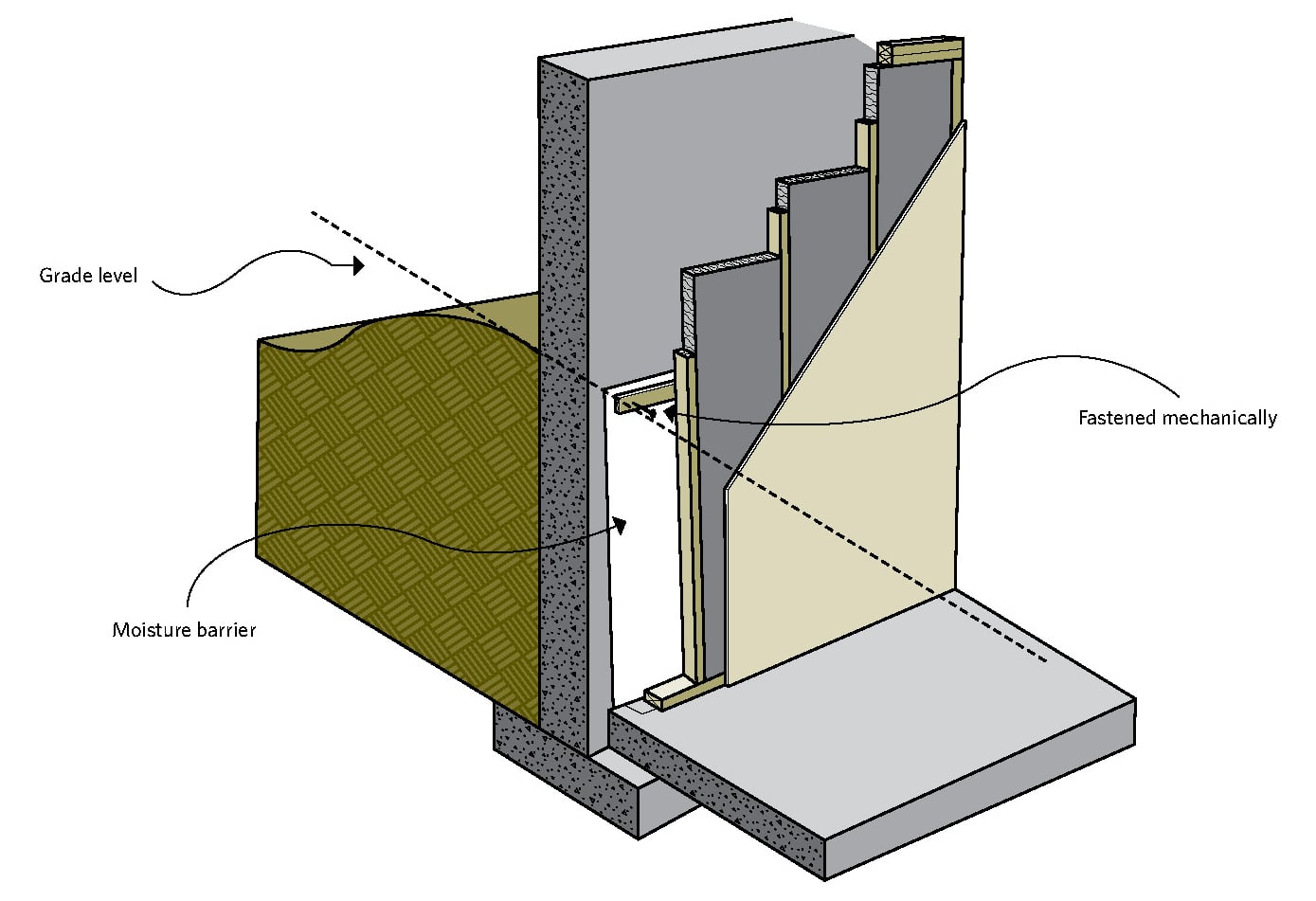
Insulating and heating an unfinished basement floor is essentially the same as the wall, just rotated. Place your insulating layers atop the concrete slab (polystyrene is a standard option), then install a newly finished floor.
There’s some good information in this guide on “building science”.
Insulating Basement Ceiling
Insulating and heating an unfinished basement ceiling is all about insulating the rim joists. Insulating the rim joists is some of the easiest and most effective insulation work you can do for your whole home.
Not sure what a rim joist is? In short, they’re the edge panels of your basement’s ceiling.
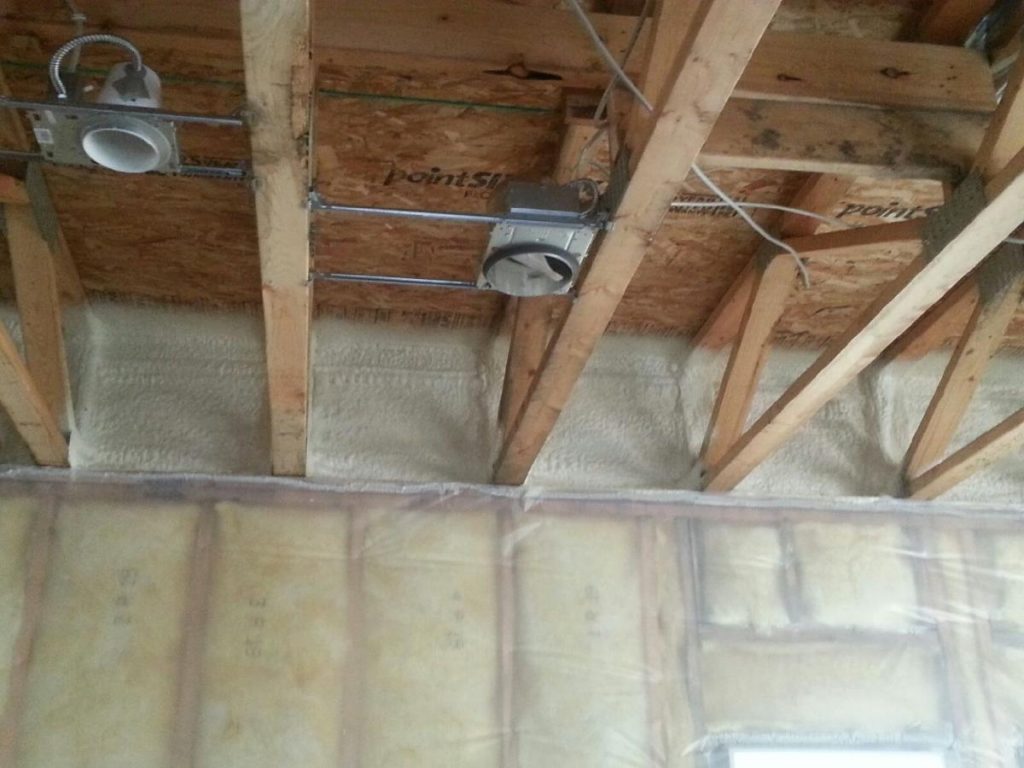
Note: depending on your light fixtures, insulation must remain away from certain types of fixtures – like the can lights featured in the photograph above. Always follow the instructions on any product packaging.
If you want to go all the way, you can apply insulation to the full ceiling to separate your basement from the rest of your home – which will also result in your floors not feeling as cold.
That said, insulating and heating your unfinished basement completely will also limit any warmth that rises up from the basement.
Spot Fixes
Looking for some quick fixes? Pick up a thermal camera (or just a light candle) and explore the basement. Seek out freezing patches, and do some ‘quick fixes’ – ideally with insulating spray foam. While quite rudimentary, patching up areas of excess cold can go a long way in heating an unfinished basement.
While it may be obvious, pay attention to any vents and ducts! Ensure any ductwork or vents in the basement are closed if you want to heat the unfinished basement separately. If you want to warm the floors above, leave them open so the heat can rise.
Why Is Your Basement So Cold?
As a tunnel engineer by trade, I’m very familiar with the ground. When it comes to basements, the key thing to note is that temperature is much more constant when below the ground, especially the further down you go.
While the ground surface might be 90F in summer and 40F in winter, the variation stops once you’re just a bit underground. In most areas, the underground temperature is around 55F (13C) all year round.
If your basement gets extra cold in winter, the walls are likely passing cold in from the ground surface. In other words, the temperature of the dirt around the basement is likely a constant 55F, but the top of the basement walls may be freezing cold because they’re so close to the ground surface.
How Much Is Your Cold Basement Costing You In Heating Bills?
Although hot air rises, a cold basement can cause a massive heat loss, causing a big drop in your heating efficiency. I find the same can happen when you have ductwork installed in your unfinished basement.
In fact, the combination of the 2 factors often accounts for around 20% of a home’s total heat loss! To investigate further, a student from Montana University monitored his heating usage before and after installing insulation in his basement.
The result? A huge 30% saving on his heating bill! So, if your basement is always very cold during winter, it’s also almost guaranteed that it’s quite poorly insulated.

The study was based on the heating for a whole house of about 1800 sq. ft of living space. The insulation added was doubling the insulation at the rim joist to R-38, adding 1.5″ polystyrene to the concrete walls, and then building a 2″ x 4″ inside wall with some further insulation.
The cost doesn’t have to be high at all, either! From what I’ve seen, energy companies often provide rebates on any insulation supplies you purchase or work you contract. So much so that prices can frequently end up as negligible compared to the amount you save on bills.
Contact a local insulation contractor to find out what’s possible in your area. Local insulation contractors typically have partnerships with energy suppliers for such jobs.
(Renting? Don’t worry – as long as you pay the utilities; you can get a rebate). Find some more info at the ‘Insulation Institute’.
Bottom line? Insulation is always worth the time and money.
How to Efficiently Heat an Unfinished Basement
You’ve got a few different ways to heat an unfinished basement. As much as I’ve gone on about insulation, that’s actually the first option! If you insulate well enough, you’ll find that the natural heat is more than enough to make your basement and the rest of your house habitable.
If you do a miniature insulation project, don’t immediately spend your money on a heater. Wait a few days, and see what difference the insulation makes. If you’re still cold, consider alternate options.
Modifying your HVAC
Adding a diversion to your furnace and directing it to your basement will give you one of the most efficient ways of heating your unfinished basement.
Through the process, you’ll lose a heat sink and gain a heat source.
Space Heaters
In my opinion, space heaters are the easiest hassle-free way to heat your basement and enjoy a warmer home instantly. There are many options out there, so I want to mention some of the different types available on the market.
My 3 favorite options are:
- Oil-Filled Heaters.
- Infrared Heaters.
- Propane Heaters.
Best Space Heaters for Unfinished Basements
Oil-filled heaters are the best option in terms of long-lasting heat.
Such heaters take a while to heat up, but then they’re excellent at maintaining that heat. Normally heat preservation is done with an ‘eco’ mode, which uses minimal power to maintain the heat.
Once warm oil-filled heaters essentially act like a standard electric space heater. Just using much less power. In my opinion, oil-filled heaters are ideal for basements due to their cheap, long-lasting heat.
The controls are also so easy to use. The model that I recommend (above), is packed full of digital settings. You can set your ideal temperature on the thermostat – and then, most importantly, you can set a timer to switch it off.
Using a timer will save you so much hassle of going down to the basement and turning off the heater later.
| Pros | Cons |
|---|---|
| Long lasting heat. | Takes long to heat up. |
| Great energy efficiency. | |
| Digital Thermostats. | |
| Remote Control Included. |
Our Verdict
Oil-filled heaters would be the simplest option for an unfinished basement. Though they take a while to warm up, their long-lasting and inexpensive heat is ideal.
Plus, the modern controls make models like the above super easy to use. That model’s also got a fantastic design, includes a remote control for ease of use, and is generally the best oil heater I’ve found.
Want to see more oil-filled heater options? Click to see my full guide to the best models for large spaces (like basements!).
In terms of cheap-to-run heat, infrared is the best option. Hands-down.
Infrared works by heating objects, not the air, and because of the way they work, they need less electricity to provide the same amount of heat.
Infrared heaters are also perfect for drafty basements since they heat objects and not the air. When turned off, all the heat isn’t gone the second a cold draft blows in.
The main downside of infrared heaters is you can’t set a target temperature. In a basement, though? Not that big of a deal! Especially if you’re looking to heat up the rest of the home.
Modern infrared models should also come with timers and eco-modes to keep energy usage low and switch off when you want them to. The model I’ve recommended above is a fantastic tower option, which will easily heat a whole large basement. Many other options are available.
| Pros | Cons |
|---|---|
| Heats objects; great for drafty areas. | Heat fades as soon as heater is off. |
| Super silent. | |
| Top for energy efficiency. |
Our Verdict
If you’re going to be spending time in your basement, infrared is a great choice.
It’s the best for a drafty location since you don’t lose the heat due to gusty air. It’s also the cheapest to run thanks to using less electricity.
For overall heating, I’d recommend a quality tower model like the one pictured above. You can also get fantastic heaters in the form of wall panels, wall heaters, or even targeted floor heaters!
Want to see more infrared heater options? They’re covered in my ‘Cheapest Electric Heater to Run‘ guide!
My last recommendation is propane heaters.
Consider these ‘bad boys’ if you’re needing some extreme levels of heat or if your unfinished basement is just super drafty.
The link below goes to the “Mr. Heater” range, which has 3 levels:
- 25k BTU.
- 30-80k BTU.
- A whopping 75-200k BTU!
If you require some extreme heat, these heaters are the way to do it. Since they’re powered by propane, they’re super easy to place.
No electric socket is necessary, so no worries. However, the one rule is you do need ventilation when using propane heaters in enclosed spaces like garages.
Please don’t get a propane heater if there’s not enough airflow in your basement!
| Pros | Cons |
|---|---|
| HUGE heating power. | Needs ventilation. |
| Doesn't need plugged in. | |
| Can be placed anywhere. |
Our Verdict
I’d recommend propane to anyone with a cold, unfinished basement. It’s probably the only heat form capable of overpowering those kinds of conditions.
Propane itself is cheap to use, and the power of the heaters is just ridiculous. They’re not the most modern – in fact, they’re quite rudimentary, but man, do they work!
Looking for more propane heater options? Click that link to our guide to the best ones for garages – which equally applies to basements.
Conclusion
As you may have realized, the answer to heating an unfinished basement is always “Insulation, Insulation, Insulation!”
It’s boring, but it’s true. Not only insulating your basement but your attic too. By keeping the heat in, you’ll keep the cold out and keep your costs down. Then, all you need is the smallest of heat sources to avoid those cold floors.
I’m trying to make this website a great source of information for all homeowners. I hope this article has helped you decide on how to tackle your unfinished basement’s heating challenges. If so, please support us by checking out some more of our posts below and subscribing to our newsletter!
Thank you for reading, have a great day.
— Craig.



